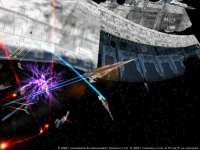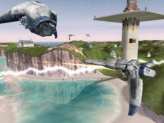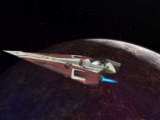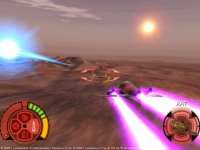


Acting
as a sort of preview of Episode II, LucasArts’ brilliant Star Wars: Jedi
Starfighter on the PS2 transports players into a central role in a battle
against the corrupt Trade Federation. With improved controls making for more
intuitive combat, superb individual mission structure and better gameplay
balance, this improves an already great franchise. Look inside as we examine the
improvements, most of which significantly enhance the experience and make this
one of the best PS2 shooters to date.
One of the most impressive PS2 launch titles was LucasArts’ stunning Star
Wars: Starfighter. Now, an improved version of that title hits in the form of
Jedi Starfighter. While the first game was fantastic in most aspects, the newest
installment features numerous enhancements including 2 player cooperative
missions, and a much improved graphics engine that moves the series forward with
several significant steps. While the feel of the gameplay and the chapter-based
mission structure is similar to the first game, it has been streamlined. Jedi
Starfighter has been rebalanced and tweaked to make this installment become a
more seamless experience. The game follows two main characters which include the
Nym character from the first game who returns much older and more cynical as
well as Adi Galliya, a female Jedi Knight who pilots the prototype Jedi
Starfighter. The plot in Jedi Starfighter parallels the movie and intersects at
some key points with Attack of the Clones. So be warned before you play, there
are some areas which might spoil parts of the movie for you. The missions seem
more cohesive this time
around. Instead of switching from character to character, both of these main
characters play a key role in the plot throughout and the interwoven storyline
makes Jedi Starfighter feel more cohesive than the first game which seemed a bit
confusing at times thanks to the changing locales and characters.
The first Starfighter game was excellent but some players had issues with its
interface, which took awhile to get the hang of and use effectively. Thankfully,
while they retain a similar feel, the controls are significantly different this
time having been tweaked to make them easier to understand. Players will find
both of the main craft are quite nimble and dexterous. The two main ships
operate similarly to each other from a technical standpoint with turning speed
becoming faster when you’re braking while slowing when accelerating. It’s
simple to implement the spinning and rolling with the craft thanks to the analog
sticks. Getting the hang of the controls is made easier to understand thanks to
the extensive training missions. The interface is intuitive and simple while
also allowing for some completely new abilities.
The HUD display interface has
been made much simpler yet more powerful, allowing you to cycle through enemies
and target the ones you want to hit. In addition, there’s a new
"Revenge" targeting mechanism. Using this, you can auto-target the
specific enemy craft who last fired on you, allowing you to inflict retaliatory
damage swiftly. The design is also simpler this time around, with clearer icons
making things more intuitive. This makes Jedi Starfighter more accessible than
its predecessor, while still making for involving and challenging gameplay. The
shield and power indicators for each enemy fighter allows for much easier
targeting and make the streamlined combat easier. Another substantial change in
Jedi Starighter comes in the operation of the wing-man system. This system has
undergone substantial renovations to make it easier to use, and also much more
effective. In addition to calling on them to perform standard defensive moves
and mission status operations, you can now order the wingmen to attack your
targeted craft, making for easier battles. Your weapons system has also been
enhanced, and the new targeting indicators increases the craft’s accuracy when
dropping bombs or launching missiles. This has become a more integral part of
the game and enhances its immersion significantly, making the experience much
more enjoyable. In Jedi Starfighter, you actually feel like you’re leading a
squadron into battle, and the urgent cross-talk makes it that much more
exciting.
 One
of the most immediately noticeable enhancements in both the controls and the
overall feel of the game comes when you play as Adi, the Jedi Knight. While she
has all the standard abilities that Nym has, including use of the Wingmen,
different weapons and a nimble craft, she has a huge advantage. Her Jedi
Starfighter prototype crafts allows her to call on her powerful alliance with
The Force. In her ship, there’s a Force energy bar at the left of the screen,
and when it’s fully powered up, Adi can then use the Force in battle. She can
choose unleash it in a variety of ways. One of the best uses is for devastating
lightning attack that can destroy several smaller ships or objects in close
proximity. The Force can also be used to make the ship invulnerable for a short
period of time when the Force Shield is turned on. While it’s quite powerful,
the Force effect only lasts for a short period of time, so it needs to be used
wisely. You’ll also quickly realize that the Force Lightning can’t be used
against larger craft, which is annoying. However the coolest ability this grants
her is that Adi can use the Force to slow down time itself, which is an
astonishing effect. This is quite effective when you’re facing a full-fledged
assault and need to shoot dozens of objects quickly. This power is really
effective and gives Jedi Starfighter a unique feel that differentiates it
substantially from the first game, while keeping the essence of the series
largely intact.
One
of the most immediately noticeable enhancements in both the controls and the
overall feel of the game comes when you play as Adi, the Jedi Knight. While she
has all the standard abilities that Nym has, including use of the Wingmen,
different weapons and a nimble craft, she has a huge advantage. Her Jedi
Starfighter prototype crafts allows her to call on her powerful alliance with
The Force. In her ship, there’s a Force energy bar at the left of the screen,
and when it’s fully powered up, Adi can then use the Force in battle. She can
choose unleash it in a variety of ways. One of the best uses is for devastating
lightning attack that can destroy several smaller ships or objects in close
proximity. The Force can also be used to make the ship invulnerable for a short
period of time when the Force Shield is turned on. While it’s quite powerful,
the Force effect only lasts for a short period of time, so it needs to be used
wisely. You’ll also quickly realize that the Force Lightning can’t be used
against larger craft, which is annoying. However the coolest ability this grants
her is that Adi can use the Force to slow down time itself, which is an
astonishing effect. This is quite effective when you’re facing a full-fledged
assault and need to shoot dozens of objects quickly. This power is really
effective and gives Jedi Starfighter a unique feel that differentiates it
substantially from the first game, while keeping the essence of the series
largely intact.
A large reason why the first game
was so exciting and addictive were its the long, cinematic missions. The
original Starfighter’s missions were complex, had multiple objectives which
helped to immerse the player into the action. This legacy continues in Jedi
Starfighter because its Mission structure is similar, several long missions with
multiple objectives, plus hidden and bonus objectives. These can unlock bonus
missions and bonus craft which can be used in the missions again. Missions are
still quite long but the sustained action and intensity is one of the key
elements in Jedi Starfighter’s appeal. The battles in this game seem much more
intense and have you facing off with dozens of ships and enemies at once. The
enemies have also been given more intelligence and aggression than the first
game, making them harder to destroy. They have a tendency to attack in large
numbers and these swarms in later levels which can become almost overwhelming.
The sheer number of objects on
screen is quite impressive. This however, is just one element of the visual
appeal of the game but it stands as a testament to the amount of graphic work
has gone into Jedi Starfighter’s powerful, undeniably impressive engine. What’s
even more impressive is that there is now more variety in the number and types
of objects in the game giving it a more epic feel than the first game. The
jaggies that plagued early PS2 titles are almost nonexistent and the texture
mapping is also significantly better, with individual objects featuring improved
texture mapping plus an increased polygon count. There’s a whopping 40
different types of ships and objects in the game. These show a much greater
range of detail and movement than they did in the first game. A powerful engine
also means that the transitions between cinematic and gameplay sequences is
virtually seamless, making the experience that much more like the movies.
Jedi Starfighter’s incredibly rich and stunning environments, likewise have
been greatly improved and take place both in the surface of planets and in deep
space. Some of the planetary levels are quite beautiful and astonishing,
implanting light-sourcing and reflections perfectly. The level designs offer
visual variety and are impressively done to the point that you feel like you’re
watching the movie. The sound effects are excellent, as is the voice acting
which is most noticeable in the excellent cut-scenes which expose the plot.
There’s also a good mix between original compositions and John Williams’
score, which adds to the urgency of the missions, making this feel like Star
Wars. All the elements combine brilliantly to showcase some of the best
production values seen in a PS2 game to date and should thrill Star Wars fans
with it’s evocative yet accurate recreation of this science fiction landmark.
This is a showcase title and its increased attention to detail that makes this
experience visually one of the best to date on the PS2.
As an added feature Jedi
Starfighter also features two player cooperative missions that lets you and a
friend battle the Trade Federation together. The multiplayer missions share the
same outstanding visuals and intelligent level designs as the rest of the game
but don’t really have much of an effect on your progress in the main game
which makes them seem almost beside the point. Fortunately, the single player
game is so excellent, the fact that the multiplayer modes seem to be
afterthoughts doesn’t really matter. The game’s overall structure is
excellent, though once again suffers from the repetitive nature that plagued the
first game. In order to unlock all the secrets in the game, some of the missions
have to be replayed multiple times before all the hidden and bonus objectives
can be completed. This is annoying but doesn’t really detract from things as
much as you’d think it could have because the missions are so immersive and
evocative. The improved visuals, soundtrack and excellent voice acting give it a
dynamic cinematic feel, making for an intense gameplay experience. In summation,
Jedi Starfighter is a highly polished, thoroughly enjoyable game that should
appeal to both the casual and hardcore Star Wars fan.
> Related Reviews:
Star Wars: Starfighter (PS2)
Star Wars: Obi Wan (Xbox)
Star Wars: Racer Revenge (PS2)
Star Wars: Rogue Leader (Gamecube)
>
What do you think? Post
your thoughts on this review in the Laser forum

